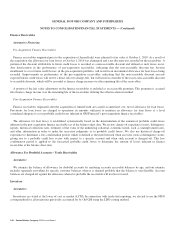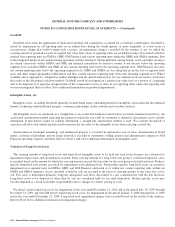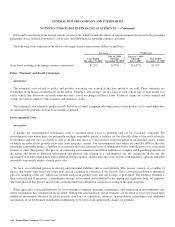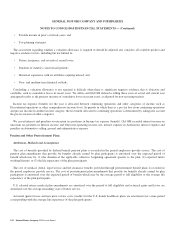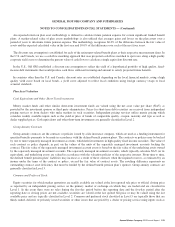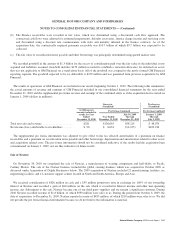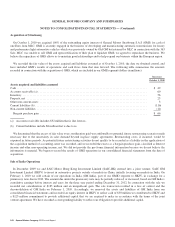General Motors 2010 Annual Report Download - page 158
Download and view the complete annual report
Please find page 158 of the 2010 General Motors annual report below. You can navigate through the pages in the report by either clicking on the pages listed below, or by using the keyword search tool below to find specific information within the annual report.GENERAL MOTORS COMPANY AND SUBSIDIARIES
NOTES TO CONSOLIDATED FINANCIAL STATEMENTS — (Continued)
aged (stale) pricing, and/or other qualitative factors. We may consider other security attributes such as liquidity and market activity in
assessing the observability of inputs used by pricing services or dealers, which may affect classification in the fair value hierarchy.
Government, Agency and Corporate Debt Securities
U.S. government and government agency obligations, foreign government and government agency obligations, municipal
securities, supranational obligations, corporate bonds, bank notes, floating rate notes, and preferred securities are valued based on
quotations received from independent pricing services or from dealers who make markets in such securities. Pricing services utilize
matrix pricing which considers readily available inputs such as the yield or price of bonds of comparable quality, coupon, maturity
and type as well as dealer supplied prices and are generally classified in Level 2. Securities within this asset class that are classified in
Level 3 are typically priced by dealers and pricing services that use proprietary pricing models which incorporate unobservable inputs.
These inputs primarily consist of yield and credit spread assumptions. We may consider other security attributes such as liquidity,
market activity, price level, credit ratings and geo-political risk in assessing the observability of inputs used by pricing services or
dealers, which may affect classification.
Agency and Non-Agency Mortgage and Other Asset-Backed Securities
U.S. and foreign government agency mortgage and asset-backed securities, non-agency collateralized mortgage obligations,
commercial mortgage securities, residential mortgage securities and other asset-backed securities are valued based on quotations
received from independent pricing services or from dealers who make markets in such securities. Pricing services utilize matrix
pricing which considers prepayment speed assumptions, attributes of the collateral, yield or price of bonds of comparable quality,
coupon, maturity and type as well as dealer supplied prices and are generally classified in Level 2. Securities within this asset class
that are classified in Level 3 are typically priced by dealers and pricing services that use proprietary pricing models which incorporate
unobservable inputs. These inputs primarily consist of prepayment curves, discount rates, default assumptions and recovery rates. We
may consider other security attributes such as liquidity, market activity, price level, credit ratings and geo-political risk in assessing
the observability of inputs used by pricing services or dealers, which may affect classification.
Investment Funds, Private Equity and Debt Investments and Real Estate Investments
Exchange traded funds and real estate investment trusts, for which market quotations are readily available, are valued at the last
reported sale price or official closing price as reported by an independent pricing service on the primary market or exchange on which
they are traded and are classified in Level 1. Investments in non-exchange traded funds and certain SPEs (e.g., limited partnerships,
limited liability companies), which may be fully redeemed at NAV in the near-term (within 90 days), are generally measured at fair
value on the basis of the NAV provided by the investment sponsor or its third party administrator, and generally classified in Level 2.
Investments within this asset class that are classified in Level 3 include investments in funds, which may not be fully redeemed at
NAV in the near-term, and are typically measured on the basis of the NAV. Level 3 investments also include direct private equity,
debt, and real estate investments, which have inherent restrictions on near-term redemption. Fair value estimates for direct private
equity, private debt, and real estate investments are provided by the respective investment sponsors and are subsequently reviewed
and approved by management. In the event management concludes a reported NAV or fair value estimate (collectively, external
valuation) does not reflect fair value or is not determined as of the financial reporting measurement date, we will consider whether an
adjustment is necessary. In determining whether an adjustment to the external valuation is required, we will review material factors
that could affect the valuation, such as changes to the composition or performance of the underlying investment(s) or comparable
investments, overall market conditions, and other economic factors that may possibly have a favorable or unfavorable effect on the
reported external valuation. We may adjust the external valuation to ensure fair value as of the balance sheet date.
Derivatives
Exchange traded derivatives, for which market quotations are readily available, are valued at the last reported sale price or official
closing price as reported by an independent pricing service on the primary market or exchange on which they are traded and are
156 General Motors Company 2010 Annual Report


